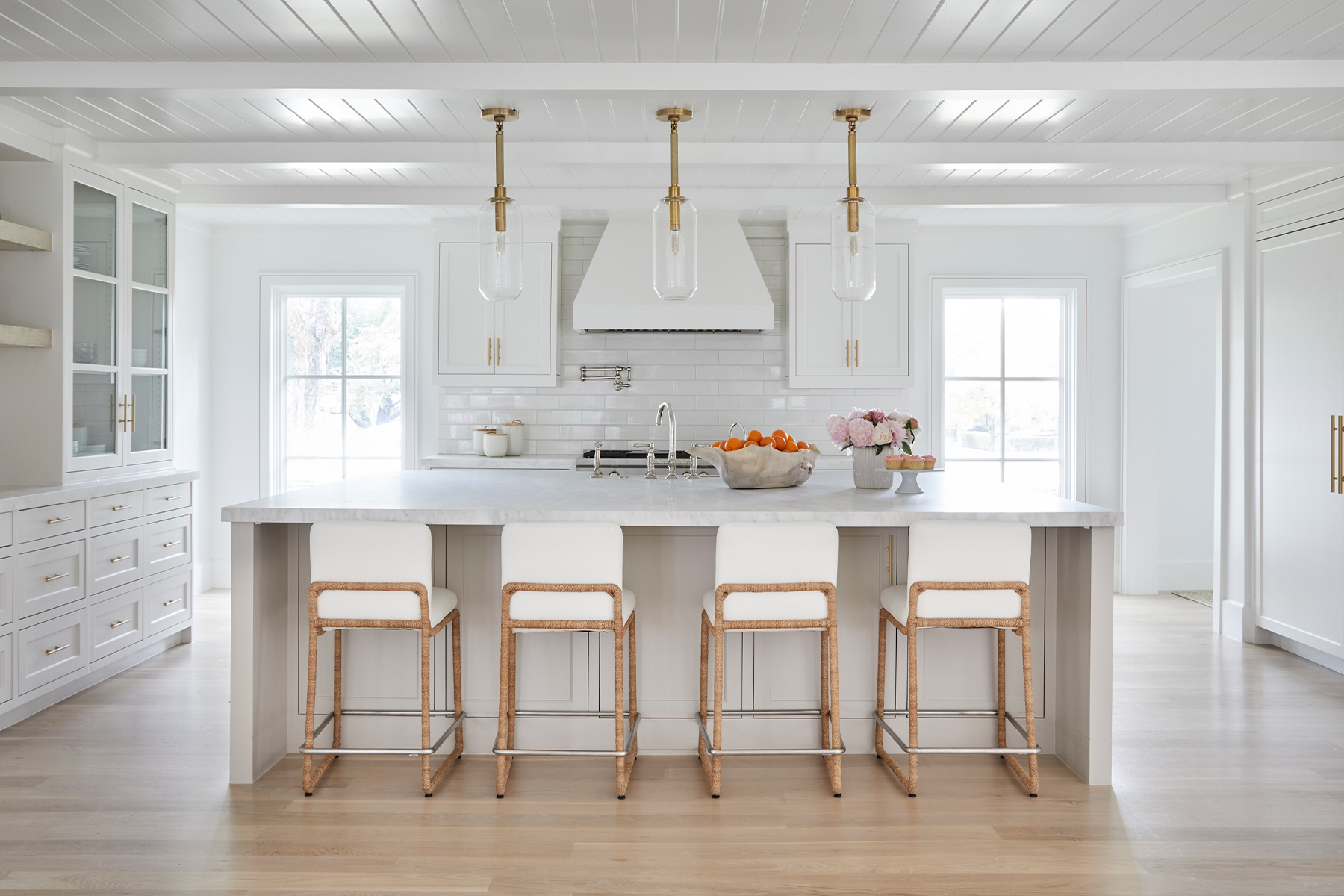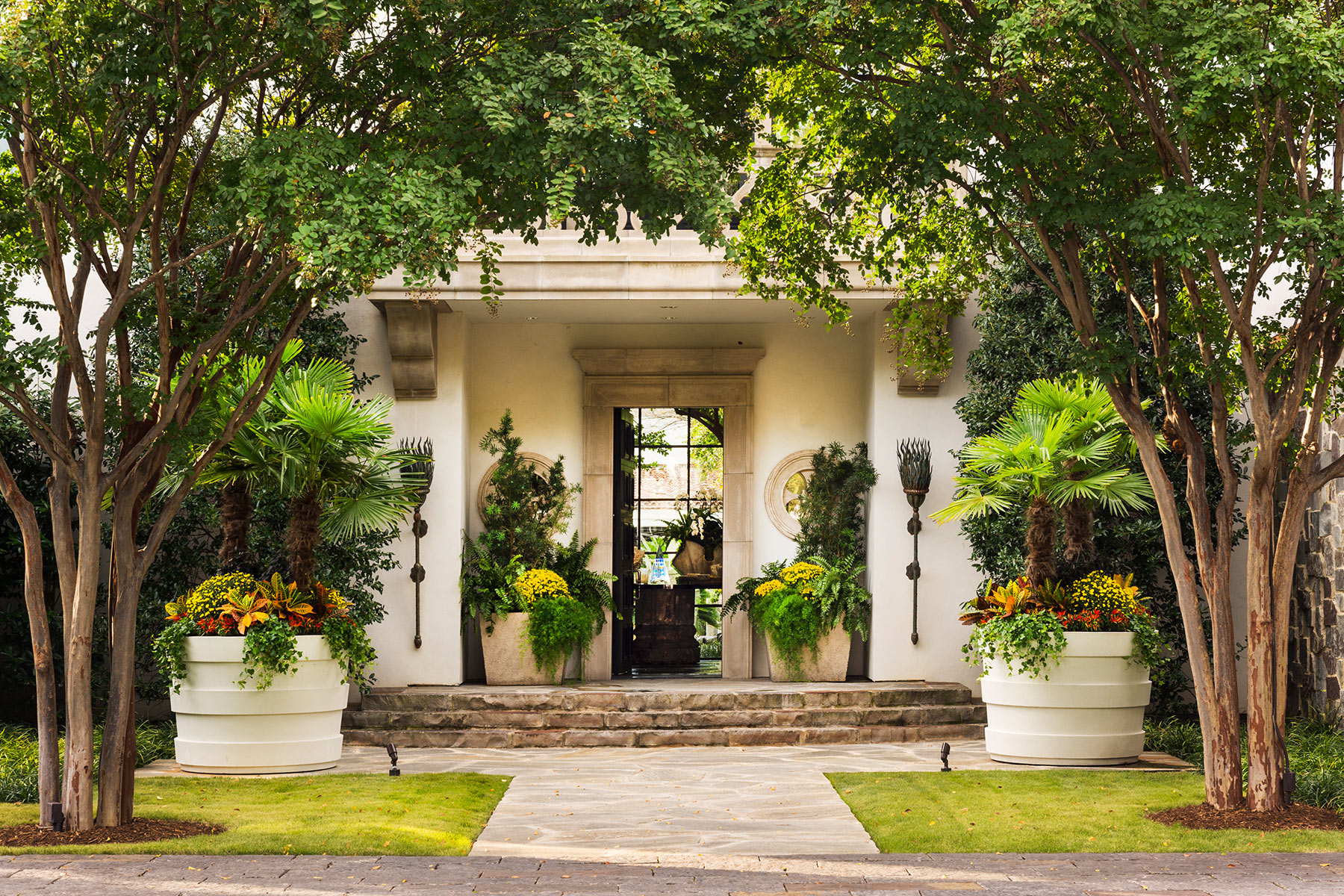When it comes to translating your hard-earned money into a hand-built structure in which your loved ones will reside, that’s a good thing.
But when it comes to the realities of constructing a home in the year 2022—two years into a pandemic and in the midst of the worst global supply-chain challenges of our lifetime—their unwillingness to sugarcoat hard truths can make for some tough pills to swallow.
“Right now, there is no such thing as having a stress-free building process,” says Charles A. Barnett of Charles A. Barnett III, Inc. “If anybody tells you that [they can make it stress-free], they are not being truthful.”
The expression “nothing worth having comes easy” might be a good mantra for homebuilding clients today. And indeed, as anyone who’s built their dream home (with a reputable builder, anyways) can tell you, the end result is most certainly worth having—blood, sweat, dollars, and all.
Herewith, our Best Builders 2022—each of them of the highest repute, not to mention unflinchingly honest— share the 20 things they want you to know to help make the homebuilding process easier
1.
Understand that there’s no such thing as a stress-free build.
In case we weren’t clear enough, we’ll say it again: It’s simply not realistic for the process of building a completely custom home to be without hassle—especially given the conditions we’re currently facing. “Permitting in Dallas is horrible, materials costs may change weekly, and materials lead times are ridiculous,” says Tom London of Thomas Signature Homes. That’s not to say the process isn’t worthwhile, just that you’ve got to be prepared for inevitable bumps along the way. If you prefer a smoother road, suggests London, “Buy a spec house that is at drywall stage.”
2.
It’s crucial to hire the right people …
“Not all builders are the same—there are different levels of quality, craftsmanship, materials, trades, suppliers, expertise, and knowledge,” says Tony Visconti of Bella Custom Homes. So how do you separate the so-so from the superb? “Do your research,” he says. “Check not only client references, but trade and bank references as well. Visit not only completed homes, but homes the builder has under construction too.” Tekton Built’s Brian Campion emphasizes the importance of finding a builder who can guide you with “steadfastness and leadership,” particularly in today’s volatile market—someone “whose emotions don’t fluctuate like the price of lumber.”
3.
… and to hire them early.
It may seem counter-intuitive to hire a builder before you’ve even purchased a lot, but Peter Scott of Jim Scott and Sons says having them involved in site selection is key. “[A builder can provide] expertise about the grade, zoning restrictions, and soil conditions—all of which can impact the design of the home,” he says. As ideas get put onto paper, having your builder onboard will also help you stay on budget, as he or she is able to put hard costs to pie-in-the-sky ideas. “Too often we see clients who engage an architect without a builder and design an awesome home that they love but does not fit the budget,” says Calais Custom Homes’ Paul Rostron. “Your builder should help you value engineers where possible to get the best home possible for your available budget.” But don’t stop once you’ve got your architect and builder in place. Having your entire team assembled early in the process—we’re talking interior designer, landscape designer, etc.—“ensures that the evolution of the design is aligned with both the aesthetic and the financial objectives of the client,” says Dan McKeithen of Provenance Builders. “Like a Venn Diagram, the project team is able to focus on and work toward creating overlap or common ground between design and budget.”
4.
Study up.
No one likes surprises, so educating yourself on what’s coming down the pipeline will make the ride more enjoyable. “Every builder has their own process, so it’s important for clients to learn and understand that process so they know what to expect,” says Nam Phan of Beechwood Custom Homes. “It makes for a more enjoyable experience when clients are able to follow the build process and track the build activities as they are being planned and occurring.”
5.
Forget about “price per square foot.”
“One of the most common questions we get from clients is, ‘What is the standard cost per square foot to build a home?’ The answer is, ‘It depends,’ ” says Phan. Interior design choices and material selections can skew those figures any number of ways, as can lot size and bonus space considerations (“Landscape for an acre versus a third of an acre? Two, three, or five car garage?” asks Mickey Munir of Sharif & Munir Custom Homes.) “Forty percent of the final cost of a client’s custom home is outside of the builder’s control and is determined by the level of finish-out that is desired,” says Westchester Custom Homes’ Jack Cecil. “If you build the same home for 10 different clients, you will end up with 10 different prices.”
6.
Make sure your budget is not a moving target.
This one’s pretty simple. “Don’t try to build a home that is more than you can afford,” says Adam Lingenfelter of Lingenfelter Custom Homes. “It will always add stress to the process.” Know what you can—and cannot—afford to spend, then be upfront about your budget and hold your team accountable. “Make us repeat the budgeting process until you are satisfied with every line item,” says Sustainable Structures of Texas’ Sam Hall. “If you want more money for your countertops and less money for your plumbing fixtures, we will adjust it.”
7.
Planning ahead saves time, money, and heartache.
Though your builder knows you’re anxious to get started, it’s advantageous to spend time ironing out every detail before you begin. “Frank Lloyd Wright said it best: ‘You can use an eraser on the drafting table or a sledgehammer on the construction site,’ ” says Isler Homes’ Carolyn Isler. Adds Preston Johns of Axiom Builders: “Most construction projects are like a jig-saw puzzle full of many components to get us to the final picture. Thorough preparation and planning upfront allows for a smoother process throughout the duration of your project.”
8.
Make selections (very) early.
“Now more than ever, it is crucial to have designs finalized and materials—flooring, countertop, fixtures, appliances, etc.—selected before construction begins,” says Cole Smith of Crow Bar Constructors, Inc. This helps to not only offset long lead times—Smith notes that “special-order windows and plumbing fixtures are taking up to six months for delivery, and some luxury appliances are taking up to 10 months”—but also to ensure you’re getting the most accurate estimates. “Having all designs completed and selections made before the beginning of construction greatly affects how accurate the builder can estimate the project both in terms of cost and completion dates,” he adds. Also worth noting: “Reselects for finishes are common as items are discontinued or not available,” says Southgate Homes’ Steve Schermerhorn. Your best bet if you’re on a tight timeline is to choose strategically. “Ask vendors what items are in stock and what the lead times are,” says McKinley Built Homes’ Heidi McKinley.
9.
Realize “little changes” actually have a big impact.
Once you’ve made your selections, resist the urge to second-guess yourself. Explains Todd Bonneau of Todd Bonneau Homes, LLC: “It’s difficult to fully explain how much changes slow down the process.” Clients need to understand the ripple effect that even a single, seemingly innocent adjustment—like cabinetry elevation changes—can have on the other pieces of the puzzle—like plumbing and electrical placement.
And it’s not just time spent redrafting plans or patching up walls and rerouting pipes; it’s subjecting yourself to material delays that your builder sought to avoid. Given the supply-chain challenges of today, it’s common practice to order materials early to allow for long lead times. But when a change is made, notes Alford Homes’ Greg Alford, “you have to go all the way back through engineering and start ordering pieces and parts again. Every time someone makes a change, it can set you back five, six, seven, eight weeks, easily.”
The best advice is to consult with your team, who can perform an honest risk-reward assessment. “Invite your homebuilder to weigh in on the extra time and cost associated with a change you’d like to make,” say Endurance Homes’ Brian Hunt and Heather Lee. “This will keep your timeline on track and your build within budget.”
10.
Don’t sweat the small stuff.
There are a million decisions involved with building a custom home, and they’re not all weighted equally. Don’t fret over every faceplate or you’re sure to wear yourself out. “Spend time and resources on those elements that truly are important and will influence the experience of living in the home every day,” says McKeithen. It’s wise to leverage your team’s expertise and allow them to provide you with curated options to help expedite the process. In the end, says Double Door Custom Homes, Inc.’s Michael Wilderman, “A home is like a work of art—you will not find yourself staring at each brush stroke when it is complete; you will see the home collectively as a one finished product.”
11.
Be prepared for the process to take longer than you think it will.
The best thing you can do is turn off HGTV. Television timelines are not a reflection of real life. “Homeowners should be aware that it generally takes 12 to 18 months to build a home—especially today with unforeseen delays, shortages, and tradespeople stretched so thinly,” say Hunt and Lee. “The first four to six months are spent in the design process; and the following 12 to 14 months are in construction.”
Hurry Up and Wait
“Between City of Dallas permitting delays and residential construction material backlogs, someone should expect anywhere between four to nine months of delays,” says Potenza Homes’ Christopher Petit.
What to Expect When You’re Inspecting
Inspections can feel relentless, but remember that they’re there for your protection. “Builders pay engineers, energy rating, and other third-party companies to inspect their homes to ensure the highest quality. In addition, most cities require up to 15 inspections throughout the process,” says Southgate Homes’ Steve Schermerhorn. “These are necessary and important steps.”
12.
Understand that progress won’t always happen at a steady pace.
“Custom home building progress is like a roller coaster,” says Blake Byrd of Knox Built Construction. “Some parts of the job, like framing, happen very fast. Some parts of the job, like painting, happen very slow. Don’t sweat the day by day; measure progress month to month instead of week to week.”
13.
Costs can—and will—fluctuate.
“Today, pricing has become a gamble rather than an educated estimate,” says Desco Fine Homes’ David Goettsche. The best defense is to pad your budget so you’re covered when, not if, things change. “Take your initial budget and automatically increase it by 10 to 15 percent to be safe,” says David Leite of David Leite Custom Homes. “In certain building material categories, we are facing increases that happen on a monthly basis. They aren’t always big increases, but it’s best to plan to spend a little more than what you initially thought.”
Dollars and Sense
Your builder will do everything in his or her power to offset price hikes, like ordering materials early to lock in rates. But these days, changes happen so fast that some fluctuation is unavoidable. So who assumes the additional costs? It depends. Alford Homes’ Greg Alford defines a few of the most commonly used contracts in homebuilding.
- Cost-plus contract: The client is responsible for covering all costs incurred, at market rates, plus an additional fee for the builder’s time and effort. “The negative to cost-plus is you don’t know what it’s going to cost you,” says Alford. Though cost-plus is easier for the builder, Alford says it can make for some difficult conversations if prices end up being significantly higher than the initial bid when it comes time to build.
- Fixed-price contract: The client and builder agree upon a predetermined price for the complete build. “Ninety-five percent of what I do is fixed-price,” Alford says, “but we do have an ‘escalation clause.’ ”
- What’s an escalation clause? With prices as volatile as they are today, it’s common to see these protective clauses in fixed-price contracts, which give the builder an opportunity to collect additional payment for anything beyond a 10 percent variation from the fixed price. “So I’m eating some of it,” Alford says. “It’s not a big difference between cost-plus and fixed-price today, and that’s just simply because of how the market is.”
14.
No, your builder doesn’t want to use “your guy.”
“Our success is based on the quality of our subcontractors and suppliers,” says Alford, who has worked with many of his trusted subs for nearly three decades. The homeowners benefit from getting vetted and properly insured laborers whose reliability, communication, pricing, quality of work, and the care with which they treat other subs’ work are proven. Though a lower quote may seem appealing, Alford notes that you often pay for it in other ways—not the least of which is added stress on you as the point person. Agrees Munir: “Homeowners that elect to put together the team [of subcontractors] invariably become the project manager and problem resolver, which makes for a high-stress process. Using your builder’s resources keeps all points of accountability with the builder.”
The same rule applies for materials. Google may be able to undercut your builders’ suppliers’ prices, but it won’t be there to help when something goes sour. “We do not buy anything off the internet,” says George Davis of George Davis & Associates, Inc. “We only buy from our local subs, trades, and vendors. These are the professionals who we’ve used for years, and we know if there’s any problems, we can depend on them for a satisfactory resolution and installation.”
15.
Don’t be afraid to ask questions.
Your team should be open to questions and constructive feedback; in fact, good builders welcome it. A collaborative approach with checks and balances helps rather than hurts, smoothing every rough edge so the final, well-considered result meets the client’s every need. “The client has a critical role to play balancing the artistic and visionary desires of the architect with the more practical build/performance/budget concerns of the general contractor,” says Ripple D+B’s Garrett Ratner. “Create an environment where these creative tensions can be aired and worked through collaboratively—we want your input on these matters!”
16.
Open, frequent, and respectful communication is key.
For the year or two that you’re working together, a client-builder relationship isn’t unlike one between spouses. “Building a custom home is like a marriage,” says John Hawkins of Hawkins-Welwood Homes. As with your mate, you need to be in lockstep when it comes to your goals and communication styles. “Discuss how and when you will communicate, so it doesn’t become a barrage of texts, emails, and phone calls that can’t be effectively fielded,” says Leite. Most builders prefer that all communication go through them, regardless of who does the work. “If you see something you have a question about or want to change, it’s appealing to tell the guy who is there working,” says Cecil. “The problem arises when the subcontractor submits an invoice for work that is unexpected by everyone, or that might impact costs down the road. If all communication flows through the builder/project manager, it’s the best chance at having a stress-free experience.”
17.
Mistakes are inevitable. (It’s how they’re handled that matters.)
Just because your builder has decades of experience doesn’t mean they’ve built a house exactly like yours before. “The home that you are building is one of a kind, and never been built before, so there are always surprises that pop up and challenges that occur,” says Rostron. “The key is to find a builder who has a reputation for solving problems, delivering on their commitments, and standing behind their build for years to come.” Remember: You hired your professionals for a reason. Trust them to live up to your initial expectations. “A good builder will do everything possible to make calm from chaos, but things won’t always go as planned,” says Byrd. “It is important that clients trust they hired the right builder for the job and trust in our ability to execute even when things seem chaotic.”
18.
Be patient.
Your builder can have considered every detail, crossed every T, and dotted every I—and still face delays that are beyond their control. Be flexible and forgiving. “Now, more than ever, be patient. Supply chain constraints and labor shortages have created real challenges that we as builders deal with on a daily basis,” says Leite. “We want to build you a masterpiece, under budget and on time, but there are unique challenges we are facing for the first time.”
Beyond the challenges specific to today’s market, there are also good old-fashioned acts of God that can wreak havoc on a timeline. “We do our best to plan and prepare for inclement weather, but it is a factor we cannot control,” say Raegan and Sheri Barringer of Barringer Custom Homes. As you move through the process, builders say to keep your eyes on the finish line. “Even though everyone gets anxious to move fast, try to trust in the process—it will be worth it in the end, and you won’t remember that two-week delay once you’re comfortably living in your new home,” says Heritage Blue Homes’ Lauren Garcia. “Keep the faith towards the end, and don’t cut corners because you’re ready to move in.”
19.
Be respectful.
We hope it goes without saying, but be respectful of your builder’s time—when they’re on the job, and when they’re not. “Builders are people too, with personal lives and other things going on besides just your home,” says JLD Custom Homes’ Jeff Dworkin. “Calling a builder at 8 p.m. on a Saturday night because you all of a sudden recalled you wanted different faucets is not right to the builder.”
20.
Trust your builder—and the process—and you’ll end up with the home of your dreams (and may just have a little fun along the way).
Your builder does this day in and day out. He or she has troubleshooted and perfected his or her process over the course of many years. Even if you don’t understand why something needs to happen at the speed specified or in the order outlined, give your builder the benefit of the doubt.
“There are reasons why we ask clients to work with us in a certain way and sequence to enable the home to get completed as quickly and with as high a quality as possible,” says Rostron. Ultimately, no one appreciates the feeling of being second-guessed. Says London, “The most important factor in building a home is trust—both client and builder must feel they are on the same team with the same stated goal. Enjoy the build process and be friends at the end of the project.”
Things may not always make sense to you, and in the midst of a build, they look messy from time to time—“controlled chaos,” as Leite puts it—but the same can be said for many creative endeavors. “Building a home is like making sausage,” Leite adds. “Sometimes it’s best to stay out of the kitchen until the final product is ready!”
Author










